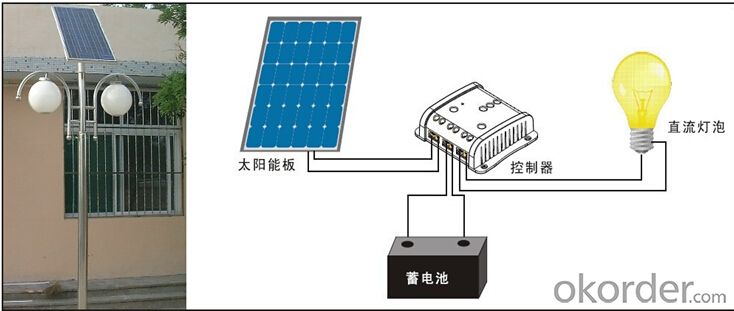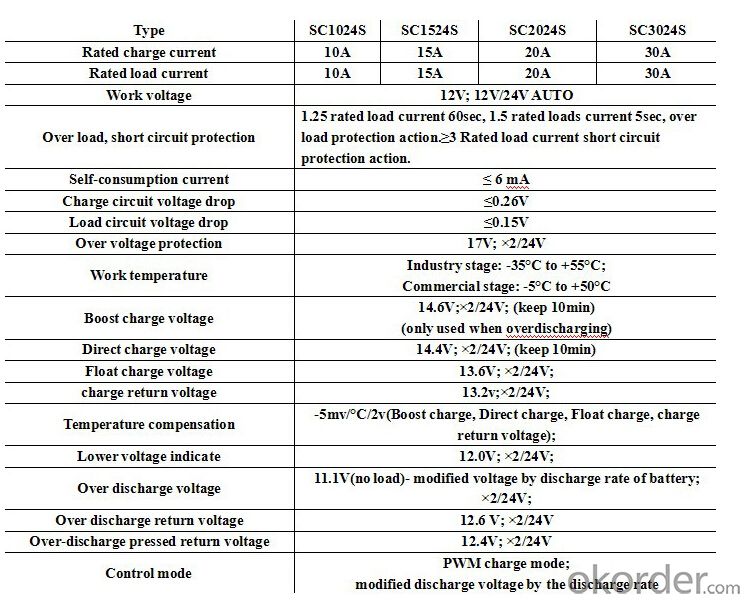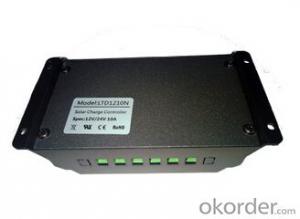BYGD Solar Charger Controller Model SC3024S for Streetlight system
- Loading Port:
- Shanghai
- Payment Terms:
- TT OR LC
- Min Order Qty:
- 10 unit
- Supply Capability:
- 50 unit/month
OKorder Service Pledge
OKorder Financial Service
You Might Also Like
Details of products:
product model: SC3024S 30A
External Size:133mm×70mm
Mounting hole Size:126mm×50mm
Performance
12V/24V automatical adaption, control and set button changed into tact key, larger contact terminal can offer wire of 6 m2
◆ double LED digital display, clear for observation
◆ recharging mode by three phases
◆ PWM pulse modulated recharging technology
◆set light-dependent control and 1-13hous time control
◆short circuit protection, overvoltage protection, overcurrent protection and lighting protection
◆standy current no more than 5mA
example

Technical characteristics

P.S.: This product is manufactured by order, so please call us for more info and service
- Q:Can a solar controller be used with a solar-powered camping setup?
- Yes, a solar controller can be used with a solar-powered camping setup. A solar controller regulates the charging and discharging of batteries, ensuring they are charged efficiently and protected from overcharging or discharging. This can be particularly useful in a camping setup where reliable power supply is essential and optimizing battery performance is important.
- Q:Can a solar controller be used with different types of solar panel anti-theft systems?
- Yes, a solar controller can be used with different types of solar panel anti-theft systems. The solar controller's primary function is to regulate and control the charging of batteries from the solar panels. It does not directly interact with the anti-theft systems, which are designed to prevent theft or unauthorized access to the solar panels. Therefore, as long as the solar controller is compatible with the specific solar panel setup and can effectively charge the batteries, it can be used in conjunction with any type of anti-theft system.
- Q:Can a solar controller be used with solar panels that are partially covered?
- Yes, a solar controller can be used with solar panels that are partially covered. However, the efficiency and effectiveness of the solar panels may be compromised if they are partially shaded. It is important to note that shading reduces the overall power output of the solar panels, so it is always recommended to have maximum exposure to sunlight for optimal performance.
- Q:Can a solar controller be used with solar panels that are connected to a charge controller?
- Yes, a solar controller can be used with solar panels that are connected to a charge controller. In fact, it is a common setup in solar power systems. The charge controller is responsible for regulating and controlling the charging process of the batteries connected to the solar panels. On the other hand, a solar controller, also known as a solar charge controller or solar regulator, is designed to regulate the voltage and current coming from the solar panels to ensure that it is suitable for charging the batteries. The solar controller plays a crucial role in protecting the batteries from overcharging and over-discharging, which can greatly extend their lifespan. It also helps to maximize the efficiency of the solar panels by preventing any mismatch between the panel's output and the battery's charging requirements. By using a solar controller in conjunction with a charge controller, you can ensure that your solar panels are operating optimally and your batteries are properly charged, resulting in a more efficient and reliable solar power system.
- Q:Can a solar controller be used with solar panel fire detection systems?
- Yes, a solar controller can be used with solar panel fire detection systems. A solar controller is responsible for regulating the voltage and current that flows between the solar panels and the battery or load. It ensures that the solar panels are operating at their optimum level and protects the system from overcharging or undercharging. In the context of solar panel fire detection systems, the solar controller can play a crucial role in managing the power supply to the detection system. It can ensure that the solar panels are generating enough power to operate the detection system effectively while also preventing any damage to the system due to overvoltage or power fluctuations. Additionally, a solar controller with advanced features such as temperature monitoring and fault detection can provide an added layer of safety to the fire detection system. It can detect any anomalies or malfunctions in the solar panels or the overall system and take necessary actions to prevent any potential fire hazards. Therefore, integrating a solar controller into a solar panel fire detection system can enhance its performance, efficiency, and safety by ensuring proper power management and protection.
- Q:How do I prevent undercharging of batteries with a solar controller?
- To avoid undercharging batteries when using a solar controller, there are several important measures you should take: 1. Choose the appropriate solar controller: It is crucial to select a solar charge controller that is specifically designed for your battery type. Different batteries have different charging requirements, and using an incompatible controller can lead to undercharging or overcharging. 2. Determine the correct size for your solar array: Ensure that the wattage of your solar panels is sufficient to fulfill the energy needs of your battery system. If the solar array is too small, it may not generate enough power to fully charge the batteries, resulting in undercharging. 3. Establish the proper charging parameters: Most solar charge controllers allow for adjustments to voltage set points and charging algorithms. Consult the manufacturer's instructions or user manual to identify the optimal settings for your battery type, and configure the controller accordingly. 4. Monitor battery voltage and state of charge: Regularly check the battery voltage and state of charge using a battery monitor or voltmeter. This will enable you to assess whether the batteries are being adequately charged. Consistently low voltage or lack of expected increases in state of charge may indicate undercharging. 5. Consider temperature compensation: Some solar controllers offer temperature compensation features, which adapt the charging parameters based on the ambient temperature. This can help prevent undercharging in extreme hot or cold conditions, as temperature can impact battery charging efficiency. 6. Regularly maintain and clean your solar panels: Keep your solar panels clean and free from debris to maximize their efficiency. Dust, dirt, or shading can diminish the amount of power generated, potentially leading to undercharging. By following these guidelines, you can significantly minimize the risk of undercharging your batteries with a solar controller, ensuring they receive the necessary charge for optimal performance and longevity.
- Q:How does a solar controller regulate the charging current?
- The charging current of the solar panel and battery is regulated by a solar controller, which monitors the voltage and current levels. Its purpose is to prevent overcharging of the battery by limiting the current flow when the battery reaches its maximum voltage. To achieve this regulation, the controller employs either pulse width modulation (PWM) or maximum power point tracking (MPPT) techniques. In a PWM solar controller, the controller controls the average charging current by rapidly turning the solar panel's current on and off. When the battery voltage is low, the controller allows a maximum charging current, which gradually decreases as the battery voltage rises. This prevents overcharging and damage to the battery. On the other hand, an MPPT solar controller utilizes a more advanced algorithm to continuously track the maximum power point (MPP) of the solar panel. The MPP represents the optimal voltage and current combination at which the solar panel can deliver its maximum power output. The controller adjusts the charging current accordingly to ensure that the panel operates at its MPP, resulting in maximum power transfer to the battery. Both PWM and MPPT controllers are efficient in regulating the charging current, thus preventing overcharging and extending the battery's lifespan. The choice between the two depends on factors such as the characteristics of the solar panel, battery type, and system requirements.
- Q:How do I calculate the required charging current for a solar controller?
- To determine the necessary charging current for a solar controller, several factors must be taken into account. Firstly, the capacity of the battery being used needs to be determined. This information can typically be found on the battery label or specification sheet and is measured in ampere-hours (Ah). Subsequently, the desired charging time for the battery must be established. For instance, if the goal is to fully charge the battery within 5 hours, the battery capacity would be divided by 5. Once the desired charging time is known, the required charging current can be calculated by dividing the battery capacity by the charging time in hours. For example, if a battery has a capacity of 100Ah and it needs to be fully charged in 5 hours, the required charging current would be 100Ah / 5h = 20A. It is essential to ensure that the solar controller has a rated charging current that is equal to or higher than the calculated required charging current to guarantee efficient and safe charging of the battery. Additionally, it is advisable to incorporate a safety margin of approximately 10-20% to account for any inefficiencies or variations in solar conditions.
- Q:Solar controller can not charge what is the reason the electric power will be less than the inverter with no fixed freezer! Solar energy simply did not charge into the electricity
- Float control point voltage: the general charge is completed, the battery is also standing for some time, so that the end voltage naturally fall, when the drop to the "maintenance voltage" point, it entered the float state, are currently using PWM (both Pulse width modulation), similar to the "trickle charge" (that is, a small current charge), a low battery voltage to charge a little, a low charge on the point, an share of a place to avoid the battery temperature continues to rise, This is very good for the battery, because the internal temperature of the battery charge and discharge a great impact. In fact, the PWM method is mainly designed to stabilize the battery terminal voltage, by adjusting the pulse width to reduce the battery charge current. This is a very scientific charge management system. Specifically, at the end of the charge, when the remaining capacity of the battery (SOC)> 80%, it is necessary to reduce the charging current to prevent excessive release (oxygen, hydrogen and acid gas) due to overcharging.
- Q:Can a solar controller be used with a solar-powered library or archive?
- Yes, a solar controller can be used with a solar-powered library or archive. A solar controller is responsible for regulating the flow of electricity from the solar panels to the batteries, ensuring efficient charging and preventing overcharging. In a solar-powered library or archive, the solar controller would play a crucial role in managing the power supply, ensuring the batteries are charged properly, and optimizing the use of solar energy for all electrical needs within the facility.
1. Manufacturer Overview |
|
|---|---|
| Location | |
| Year Established | |
| Annual Output Value | |
| Main Markets | |
| Company Certifications | |
2. Manufacturer Certificates |
|
|---|---|
| a) Certification Name | |
| Range | |
| Reference | |
| Validity Period | |
3. Manufacturer Capability |
|
|---|---|
| a)Trade Capacity | |
| Nearest Port | |
| Export Percentage | |
| No.of Employees in Trade Department | |
| Language Spoken: | |
| b)Factory Information | |
| Factory Size: | |
| No. of Production Lines | |
| Contract Manufacturing | |
| Product Price Range | |
Send your message to us
BYGD Solar Charger Controller Model SC3024S for Streetlight system
- Loading Port:
- Shanghai
- Payment Terms:
- TT OR LC
- Min Order Qty:
- 10 unit
- Supply Capability:
- 50 unit/month
OKorder Service Pledge
OKorder Financial Service
Similar products
New products
Hot products
Related keywords





























